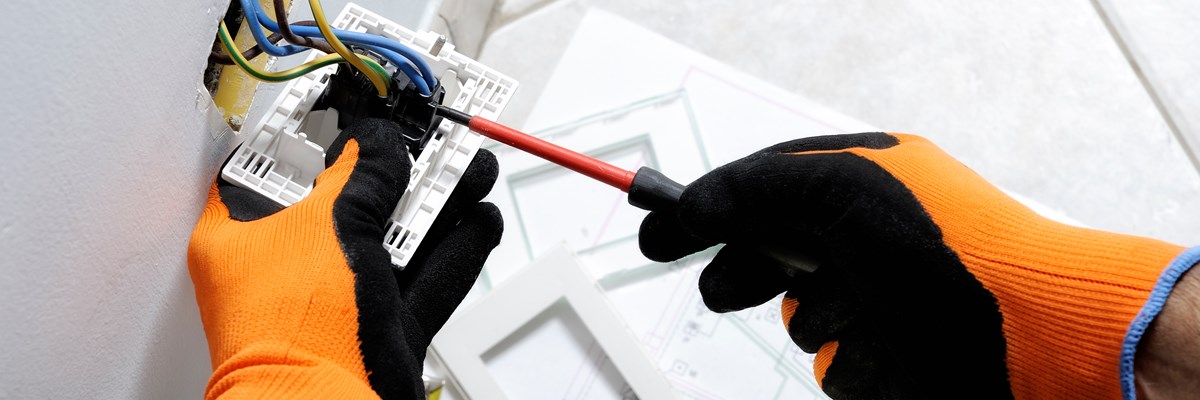Download our electrical safety best practice guides
Free expert advice and information on all the technical issues involved in electrical installation work.
Produced by Electrical Safety First in association with several other industry bodies, these downloadable guides support the work of designers, installers, verifiers, and inspectors of domestic electrical installations.
The guides cover:
- Replacing a consumer unit in domestic premises
- Safe isolation procedures
- Connecting a microgeneration system
- Electrical installation condition reporting (EICR)
- How electrical installations impact fire performance of houses
- Portable and stationary appliance testing
- Accuracy and consistency of testing equipment
- Selection and use of plug-in socket-outlet test devices
- Safe installation of retrofit LED lamps
- Electrical safety standards in private rented accommodation
We have also produced additional guidance on the minimum provision of socket outlets and best practice advice for installers on achieving safe and reliable connections.
The guides cover:
Guide 1: Replacing a consumer unit in domestic premises
To be used when a consumer unit or other main switchgear is being replaced in residential (or similar) premises which are wired in accordance with earlier versions of BS 7671 or the IEE Wiring Regulations.
This guidance provides practical advice and guidance for designers, installers, and inspectors to protect against dangerous situations which could arise from the existing installation.
Guide 2: Safe isolation procedures
Explains what needs to be done to make sure workers on site are not exposed to danger when working on or near live electrical systems and equipment in buildings, particularly in the final stages of construction, electrical installation, inspection and testing work.
Many accidents are a direct consequence of electricians not implementing safe isolation procedures on AC low voltage installations (those not exceeding 1000 V AC between conductors).
Guide 3: Connecting a microgeneration system
Provides an overview of microgeneration used to produce electrical energy (known as small-scale embedded generation or SSEG), and information on the legal and contractual issues relating specifically to the installation of microgenerators with electrical ratings up to 16 A per phase.
It also gives guidance on electrical and safety issues which can arise when installing or connecting a microgenerator.
Guide 4: Electrical installation condition reporting (EICR)
How to use the classification codes (C1, C2, C3, FI) which need to be attributed to each observation recorded during the periodic inspection and testing of an electrical installation, taking into account requirements of BS 7671.
Although focused on the likely observations associated with domestic and similar electrical installations, this guidance can be applied to similar situations in other types of installation.
Guide 5: How electrical installations impact fire performance of domestic premises
Guidance to help ensure electrical installation work does not compromise fire performance provisions which must be incorporated into domestic premises under the relevant building regulations.
It addresses the impact of electrical installations on the fire performance of loadbearing and non-loadbearing walls and floors (and sometimes ceiling membranes) which have a fire containment function, and/or are required to carry a load for a prescribed period.
Guide 6: Portable and stationary appliance testing in private rented accommodation
Landlords who provide electrical equipment or appliances for use by tenants as part of a tenancy agreement have a responsibility to maintain them in a safe condition throughout the tenancy.
This guide outlines what to consider when deciding how best to manage the ongoing safety of the electrical equipment and appliances provided for tenants.
Guide 7: Ongoing accuracy and consistency of electrical test equipment
Although BS 7671 does not require regular calibration of test instruments, it is important to keep test instruments accurate and consistent, so those responsible for testing should have an effective system to confirm and record this.
Doing so maintains confidence in the accuracy of test results and ensures any remedial action can be taken without delay if there is any indication an instrument is no longer sufficiently accurate.
Guide 8: Selection and use of plug-in socket-outlet test devices
Although all proprietary plug-in devices indicate the basic electrical faults found in socket-outlet circuits, the simpler ones often do not capture more complex – and potentially dangerous – faults.
Even an advanced or professional device cannot alone provide full assurance that a socket-outlet is safe to use. And due to a lack of knowledge of their limitations, the devices are often inappropriately used as the sole means of checking whether a socket-outlet is safe to put into, or continue in, service.
Guide 9: Safe installation of retrofit LED lamps
There are several safety concerns relating to some readily available LED (light emitting diodes) products, typically relating to the risk of electric shock occurring during installation, maintenance or inspection, and testing work. There is also the possibility of low-quality LED lamps or luminaires causing a fire.
This guide highlights potential dangers and risks associated with the use of self-ballasted LED lamps designed as a direct replacement for tungsten filament, compact fluorescent and similar lamps, as well as the conversion of fluorescent luminaires to work with self-ballasted LED lamps.
Guide 10: Electrical safety standards in private rented accommodation
This guide is aimed at private landlords, letting agents, and others responsible for the upkeep and maintenance of the electrical installation in dwelling houses used as private rented residential accommodation, and for electricians carrying out periodic electrical inspection and testing in them.
It sets out the minimum recommended degree of periodic inspection and testing necessary to meet the requirements of relevant UK legislation, and to confirm – or not – that the electrical installation is safe for continued use.
